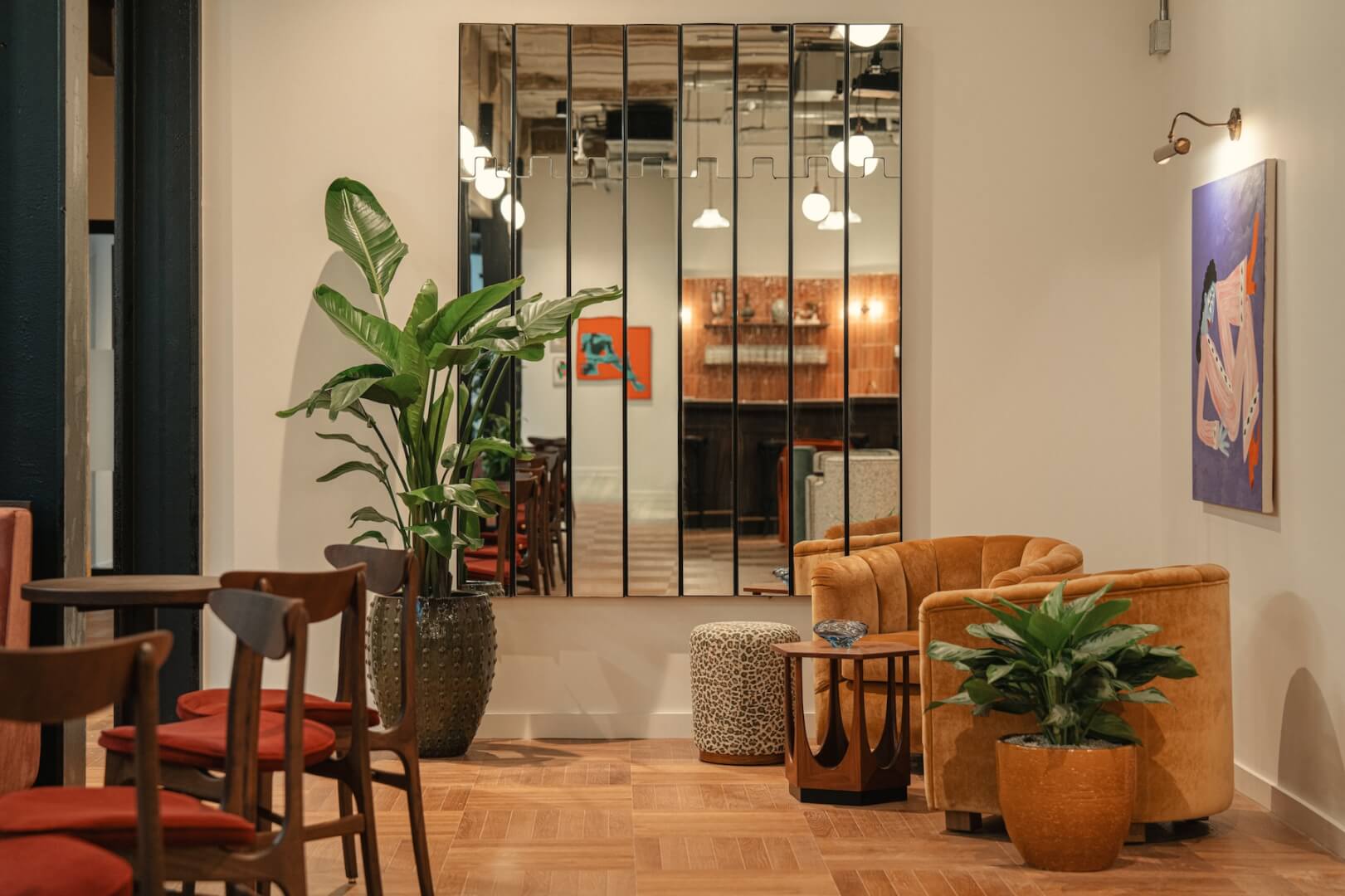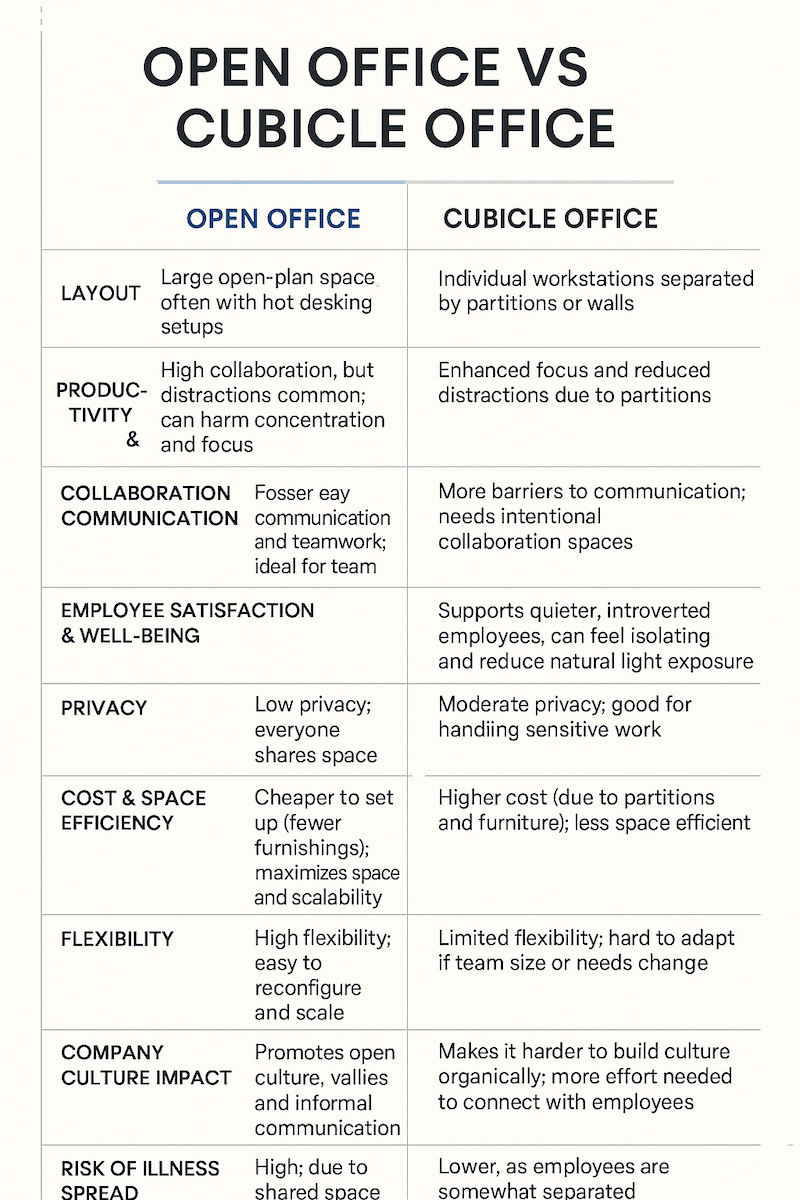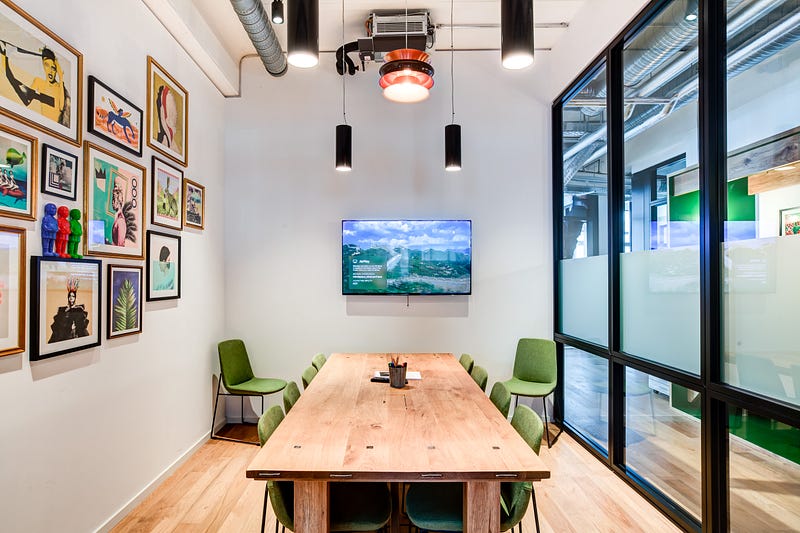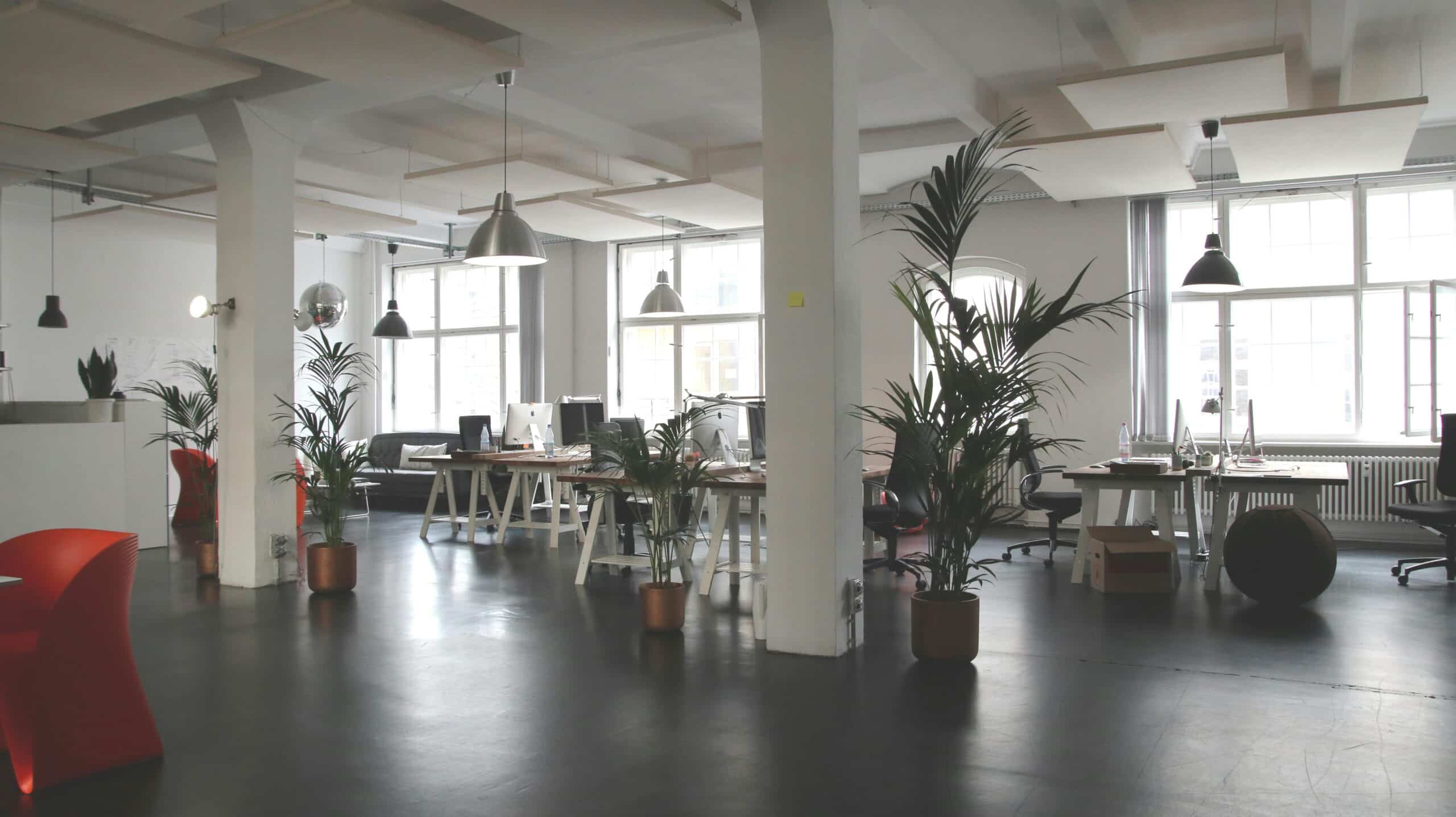
Open Office vs Cubicle – Which is Best for Productivity?
Productivity is a key concern for every business, and it’s often determined by the office spaces themselves. If you’re looking to rent an office for the first time, you’ll want to seriously consider layouts before signing and finalizing a lease. There are various different types of layouts to consider, with open-plan interiors and cubicles being among the most common. Both have their advantages, and each comes with drawbacks you’ll want to mull carefully over.
What is an Open Office?
For many businesses, open offices are a popular choice. This kind of flexible office is defined by a large, open-plan interior where employees work side by side. It stands in stark contrast to cubicle offices and those where partitions separate employees. Open offices also tend to utilize hot desking setups, rather than assigning employees to individual workstations.
In the coworking sector, open offices are the standard. They’re ideal for freelancers looking for a semi-permanent business base, provided they can get comfortable with the concept of office hoteling and shared facilities. They’re also regularly employed by major organizations, with big businesses using them to host hybrid teams and remote workers.
What is a Cubicle Office?
Unlike open offices, cubicle offices are dominated by individual cubicles and partitions that separate workers from one another. Here, workstations are permanently assigned to individuals, with employees afforded some scope for personalization. Cubicles can also be furnished with storage and other pieces of office furniture, a luxury not afforded by many open office arrangements.
A staple of corporate settings since the 1960s, the first office cubicle was designed to provide a degree of privacy in an open setting. Users benefited from enhanced levels of privacy, but weren’t completely set apart from colleagues, allowing for some collaboration. They became increasingly popular during the 1970s and are still in use today. As well as offering a degree of privacy, partitions keep distractions to a minimum, meaning that cubicles have the potential to boost output and productivity.
In a nutshell:
| Aspect | Open Office | Cubicle Office |
|---|---|---|
| Layout | Large open-plan space, often with hot desking setups | Individual workstations separated by partitions or walls |
| Productivity & Focus | High collaboration, but distractions common; can harm concentration and focus | Enhanced focus and reduced distractions due to partitions |
| Collaboration & Communication | Fosters easy communication and teamwork; ideal for team projects | More barriers to communication; needs intentional collaboration spaces |
| Employee Satisfaction & Well-being | Encourages social interaction and company culture; risk of noise and illness spread | Supports quieter, introverted employees; can feel isolating and reduce natural light exposure |
| Privacy | Low privacy; everyone shares space | Moderate privacy; good for handling sensitive work |
| Cost & Space Efficiency | Cheaper to set up (fewer furnishings); maximizes space and scalability | Higher cost (due to partitions and furniture); less space efficient |
| Flexibility | High flexibility; easy to reconfigure and scale | Limited flexibility; hard to adapt if team size or needs change |
| Company Culture Impact | Promotes open culture, values, and informal communication | Makes it harder to build culture organically; more effort needed to connect with employees |
| Risk of Illness Spread | High, due to shared space | Lower, as employees are somewhat separated |
| Suitability for Business Types | Creative industries, startups, teams needing collaboration | Roles requiring focus, privacy, sensitive tasks (e.g., finance, legal) |
| Key Disadvantages | Noise, distractions, privacy concerns, illness spread | Less collaboration, decreased employee well-being, inflexible, culture disconnect |
Open Office vs Cubicle: A Detailed Comparison
Not sure on whether to explore the prospect of an open office or play it safe with a cubicle-inspired configuration? Below, we’ll take a look at how the two compare to help you make your decision.
Productivity & Focus
Open offices are perfect for fostering creativity and promoting collaboration, but without any partitions to separate individual desks, privacy can become a concern. Distractions can also mount, affecting concentration and productivity. By contrast, cubicles help stamp out distractions, allowing for improved focus.
The statistics bear this out. According to one study, the average worker loses around 20% of their workday thanks to distractions. Meanwhile, in another study, 37% of people reported that they thought open-plan offices were affecting their productivity levels.
Collaboration & Communication
If you’re concerned your current team isn’t communicating enough, it might be time to rethink your office layout. Open offices can help break down walls and thaw the ice between colleagues who are otherwise strangers. Ideal if your business calls for a lot of team-based project work.
That’s not to say cubicles can’t support a collaborative work environment. It just means that extra steps need to be put into place to ensure open lines of communication are observed. Utilizing shared spaces like meeting rooms regularly can also help.
Employee Satisfaction & Well-being
The right office layout can have a significant impact on employee satisfaction rates and well-being. Both open offices and cubicle offices can promote this. Open-plan offices are designed with collaboration in mind, with this social element being particularly effective at raising satisfaction levels. Open office layouts and integrated technology can also help protect against contagious illnesses, making them a great fit if you want to prioritize employee well-being.
Because they’re so effective at combating distractions, cubicles can help drive the quieter, more focused employee to succeed, thereby improving job satisfaction. Because there’s still some scope for collaboration with other employees, a cubicle office can also cement your core values and beliefs, helping you create a strong corporate culture.
Cost & Space Efficiency
Open-plan offices are typically cheaper than cubicle ones. This is largely down to fewer furnishings, such as partitions, being required. Additionally, open offices tend to feature more shared facilities, bringing down the amount you’ll need to spend on a setup. Unlike cubicle offices, open offices can also make optimal use of available space. This means you can increase your headcount and boost productivity, without having to expand into larger workspaces.
Pros and Cons of Open Offices
Pros
- A More Flexible Solution: If you’re interested in a more dynamic workplace, an open-plan office is a good idea. In a typical open office, workstations aren’t necessarily assigned, with hot desking being the order of the day. Spaces can also be readily reconfigured as your requirements change.
- More Affordable Than Other Alternatives: Because you’re making a saving by not having to install cubicles and invest in countless copies of the same equipment, open offices are a relatively affordable choice. They’re even more cost-effective if you’ve enjoyed the productivity gains an open office can generate.
- Encourages Collaboration: When you do away with walls and partitions, it gets a lot easier to communicate. Open offices are designed to promote collaboration, making them ideal if your workforce regularly has to deal with team-based projects.
- Promotes Your Company Culture: It’s easier to create and uphold a corporate culture if you’re able to speak with your teams and they’re able to communicate effectively. An open-plan arrangement allows for exactly this, providing you with plenty of opportunities to share your values and beliefs directly, or with the use of signage and other aids.
Cons
- No Privacy: By their very nature, open offices don’t allow for much in the way of privacy. This may present a problem for workers who prefer to keep to their own company, while
- Lots of Distractions: Without partitions to block out noise, open-plan spaces can become rife with distractions. Whether it’s loud chatter from nearby colleagues or everyday office noises causing the problem, distractions can sap focus and reduce productivity.
- Not as Scalable as You Might Think: Although open offices can be reconfigured to an extent, there will ultimately come a time when a successful business has outgrown their current premises.
- Can Lead to Illness and Absentism: If you dread the thought of your entire workforce going off sick, you might want to rethink your choice of an open-plan office. By positioning all of your teams within a single space, you’re inviting contagious diseases like the common cold into the mix.
Pros and Cons of Cubicles
Pros
- Cost-Effective: Even though you’re using more furniture and resources than a standard office setup, a cubicle-inspired design is still a cost-effective choice and far cheaper than using many smaller bricks-and-mortar offices.
- Customizable Layouts: It’s easy to reconfigure the layout of a cubicle to an extent, making it easy to create personalized workspaces for every employee.
- No Distractions: Partitions provide a semi-enclosed work environment, meaning that distractions are kept to an absolute minimum. This can increase focus and boost productivity.
- Relatively Private: By using partitions, you afford your employees a good degree of privacy. This may spur them on to be more productive, while private cubicles are also useful when employees are dealing with sensitive material.
Cons
- Little Collaboration: Partitions might provide privacy, but they can pose a barrier to communication with colleagues. This can cause a problem when your teams need to work together, with cubicles isolating your employees from the rest of your workforce.
- Decreased Satisfaction and Well-Being: When you install cubicles into an office, things like window views and floods of natural light become a thing of the past. This is a shame, as both are thought to promote a sense of calm and improve employee well-being.
- They’re Not Particularly Flexible: There’s very little scope for customization of cubicles, with a limited amount of space available. This can be a problem if your requirements change and you need to rethink your workforce.
- Company Culture Suffers: If your employees are stationed in cubicles, it can be hard to connect with them on a daily basis. This poses a challenge if you’re looking to promote the core values and beliefs that showcase your brand and inspire your company culture.
Which Office Layout is Right for Your Business?
If you’ve only ever worked with a cubicle layout before, making the switch to an open-plan setting can seem daunting. The same applies to those who’ve only ever used an open office and are now looking for alternatives. If you’re considering an office relocation, you’ll want to consider your requirements carefully before whittling down your options.
Start by asking yourself a few basic questions. Are you having trouble promoting your company culture? It can be nigh on impossible to share your mission statement, goals, and values if everybody’s working in cubicles. Do you operate within a sector where team-based workflows are the norm? An open office that will foster collaboration is probably a good fit. You’ll also need to think about the wants and needs of your employees. Some teams like being able to communicate clearly with each other in open-plan spaces, while others prefer the semi-isolation that cubicles and partitioned areas provide.
Boost Productivity with the Right Workspace
Both open-plan offices and cubicles have their benefits. Cubicles are ideal if you value privacy, aren’t particularly concerned about collaboration, and want to improve focus. Meanwhile, open offices are highly effective at community building, can help lock down your business culture, and enhance communication.
If you’re looking for the best of both worlds, coworking venues offer a wide variety of workspaces that can help your teams succeed and your business grow. Alongside open-plan spaces filled with hot desks and shared amenities, the average coworking location offers more exclusive alternatives, such as private offices and team suites.
At Mindspace, you’ll find an extensive selection of first-class workspaces, each offering flexible membership options and plenty in the way of premium amenities. With dynamic coworking spaces located in major cities across the world, you’re free to make your base anywhere.
Feeling inspired? Why not get acquainted with our complete selection of workspace solutions? Ready to book a viewing of one of our locations? Book your spot today!
FAQs
What is the main disadvantage of an open office?
Because there’s a lack of dividers and partitions, noise and distractions can present a problem in open spaces. Privacy is also a concern.
Are cubicles outdated?
Are cubicles outdated?
Not at all. Despite being around since the 1960s, cubicles have never really gone out of fashion. If you’re looking for enhanced levels of privacy and increased output, they’re definitely worth considering.
Can you make an open office quieter?
Setting workstations apart from each other can help dampen noise in open offices. Using acoustic paneling on walls and ceilings can also help muffle excess noise.
How do companies balance privacy and collaboration?
Establishing open lines of communication can help foster collaboration, regardless of whether employees are working in a cubicle or an open-plan office. Workshops, knowledge-sharing events, and mentorships can also help promote more collaboration, even if your workers are physically isolated from one another.






